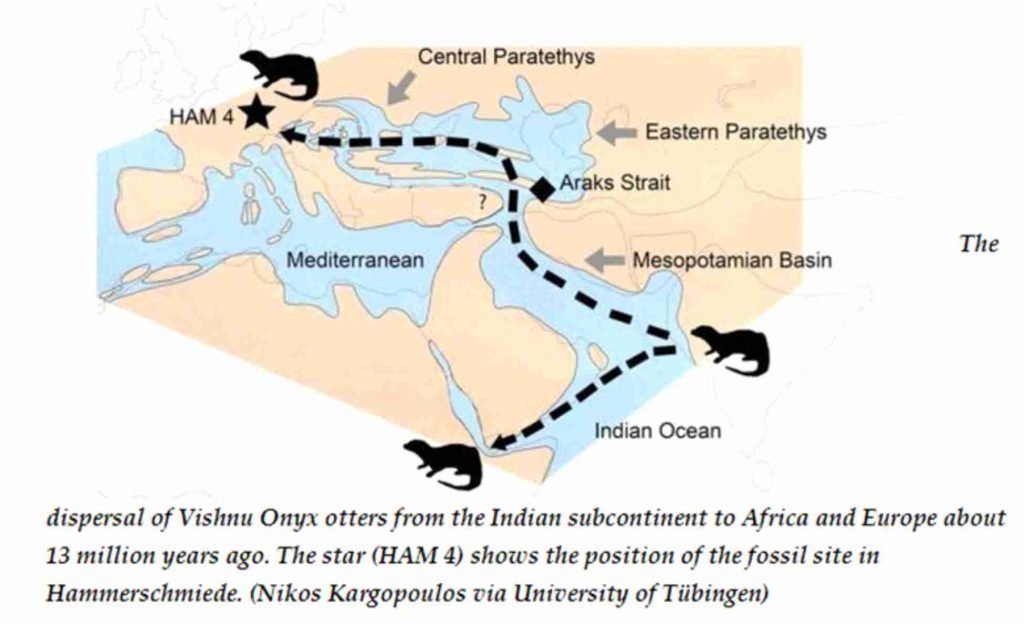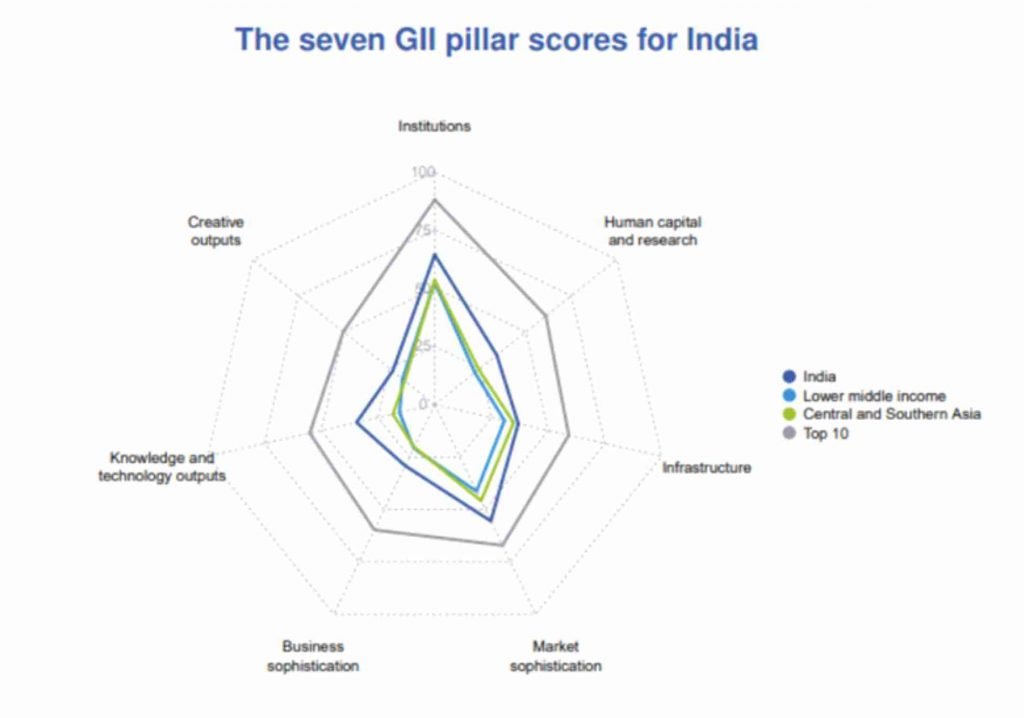Vishnuonyx
The Indian Express
GS 3: Awareness In The Fields Of It, Space, Computers, Robotics, Nano-Technology,
Bio-Technology, Pharma Sector & Health Science
Context:
- According to the discovery that has been described in the Journal of Vertebrate Paleontology, a newly found fossil of Vishnuonyx indicates it had travelled as far as Germany.
About:
- Between 12.5 million and 14 million years ago, members of a genus of otters called Vishnuonyx lived in the major rivers of southern Asia. Fossils of these now extinct otters were first discovered in sediments found in the foothills of the Himalayas.
- Researchers from the Universities of Tübingen and Zaragoza have discovered the fossil of a previously unknown species, which they have named Vishnuonyx neptuni, meaning ‘Neptune’s Vishnu’.
- The species was discovered from a 11.4-million-year-old strata in the area of Hammerschmiede, which is a fossil site in Bavaria, Germany that has been studied for about 50 years.
- This is the first discovery of any member of the Vishnuonyx genus in Europe; it is also its most northern and western record till date.
Features:
- Mid-sized predators that weighed, on average, 10-15 kg.
- Before this, the genus was known only in Asia and Africa (recent findings show that Vishnuonyx reached East Africa about 12 million years ago).
- Vishnuonyx depended on water and could not travel long distances over land.
- According to the researchers, its travels over 6,000 km were probably made possible by the geography of 12 million years ago, when the Alps were recently formed.
- These Alps and the Iranian Elbrus Mountains were separated by a large ocean basin, which would have made it easier for the otters to cross it.
- Researchers believe ‘Neptune’s Vishnu’ first reached southern Germany, followed by Ancient Guenz and eventually, the Hammerschmiede.

ADB Cuts India Growth Forecast
The Hindu
GS 3: Economy
Context:
- The Asian Development Bank in Asian Development Outlook for 2021 has cut its forecast for India’s GDP growth in 2021-22 to 10%, from 11% projected earlier, with downside risks dominating the economic outlook.
- The ADB also sees rising input costs fuelling inflation to a faster 5.5% pace, than the 5.2% previously estimated.
About:
- While the COVID-19 second wave has disrupted the economic recovery since the ADB’s April forecast for 11% growth, the Bank expects the economy to ‘rebound strongly in the remaining three quarters and grow by 10% in the full fiscal year before moderating to 7.5%’ in 2022-23.
- The primary risks are centred around the pandemic. Until really widespread vaccination is achieved, countries still are at risk of renewed outbreaks as the Delta variant is much more infectious.
- So the main risk weighing on the outlook is if vaccination hasn’t progressed widely, the health system gets strained and the government needs to put restrictions on mobility again.
- That the second wave accelerated very rapidly but also declined very rapidly, allowing the economy to reopen was another key factor behind ADB’s assessment, and was backed by the Purchasing Managers’ Index (PMI) readings that had ‘switched to highly positive for India.
- Consumption will recover only gradually, government spending and exports will contribute more to this year’s growth than they did in the previous fiscal year.
Inflation Rise:
- Due to the uptick in India’s inflation on rising global oil prices and higher duties on gasoline and diesel fuel, along with double-digit consumer price inflation for pulses and vegetable oil, and further, a deficient monsoon could augur further inflationary pressure.
- Rising prices for oil and other commodities will further increase input and transportation costs for producers, which they will pass on to consumers.
- These push factors and the second-round effects of persistently high headline inflation from last year will keep core inflation elevated.
International Blue Flag Certification
PIB
GS 3: Environmental Pollution & Degradation
Context:
- Kovalam in Tamil Nadu and Eden in Puducherry beaches has been accorded the Blue Flag Certification.
About:
- This certificate aims to protect and conserve the pristine coastal and marine ecosystems through holistic management of the resources the globally recognized and the coveted International eco-label “Blue Flag”.
- Foundation for Environment Education in Denmark (FEE) which accords the globally recognized eco-label – Blue Flag certification, has also given re-certification for 8 nominated beaches:
- Shivrajpur-Gujarat,
- Ghoghla-Diu,
- Kasarkod – Karnataka
- Padubidri-Karnataka,
- Kappad-Kerala,
- Rushikonda- Andhra Pradesh,
- Golden-Odisha
- Radhanagar- Andaman and Nicobar Islands
BEACH program:
- The Ministry of Environment, Forest and Climate Change in its pursuit of “Sustainable Development” of the coastal regions of India embarked upon a highly acclaimed & flagship program Beach Environment & Aesthetics Management Services (BEAMS).
- It is one of the initiatives under ICZM approach that the MoEF&CC has undertaken for the sustainable development of coastal regions of India.
- It aims to protect and conserve the pristine coastal and marine ecosystems through holistic management of the resources.
- This was aimed for achieving the globally recognized and the coveted International eco-label “Blue Flag” , accorded by International Jury comprising of members from IUCN, UNWTO ,UNEP, UNESCO etc.
- FEE Denmark conduct regular monitoring & audits for strict compliance of the 33 criteria at all times.
- A waving “Blue Flag” is an indication of 100% compliance to these 33 stringent criteria and sound health of the beach.
- The objective of BEAMS program is to abate pollution in coastal waters, promote sustainable development of beach facilities, protect & conserve coastal ecosystems & natural resources, and seriously challenge local authorities & stakeholders to strive and maintain high standards of cleanliness, hygiene & safety for beachgoers in accordance with coastal environment & regulations.
Global Innovation Index 2021
PIB
GS 3: Science and Technology
Context:
- India has climbed 2 spots and has been ranked 46th by the World Intellectual Property Organization (WIPO) in the Global Innovation Index 2021 rankings.
About:
- India has been on a rising trajectory, over the past several years in the Global Innovation Index (GII), from a rank of 81 in 2015 to 46 in 2021.
- The GII report is published by WIPO in partnership with the Portulans Institute, with support of corporate network partners, such as the Confederation of Indian Industry, Brazilian National Confederation of Industry, Ecopetrol Group (Colombia), and the Turkish Exporters Assembly.
- Selected middle-income economies are changing the innovation landscape, starting with China; Turkey, Vietnam, India, and the Philippines now pulling their weight.
- Top Five: Switzerland, Sweden, U.S., and K. continue to lead the innovation ranking, and have all ranked in the top 5 in the past three years.
- Asian Countries: Four Asian economies feature in the top 15: Singapore (8), China (12), Japan (13) and Hong Kong, China (14).

- Investments in innovation reached an all-time high before the pandemic with R&D growing at an exceptional rate of 8.5% in 2019.
- Government budget allocations for the top R&D spending economies showed continued growth in 2020.
- The publication of scientific articles worldwide grew by 7.6% in 2020.
- India, Kenya, the Republic of Moldova, and VietNam hold the record for overperforming on innovation relative to their level of development for the 11th year in a row.
- The GII aims to capture the multi-dimensional facets of innovation ranking and rich analysis referencing around 132 economies.
- The index ranks world economies according to their innovation capabilities and consists of roughly 80 indicators grouped into innovation inputs and outputs.

Delay in Monsoon Withdrawal
The Hindu
GS 1: Important Geophysical Phenomenon
Context:
- The withdrawal of the Southwest monsoon is expected to be delayed with a fresh rain-bearing pressure system forming in the Bay of Bengal.
- There are no signs of monsoon withdrawal from North India for the next 10 days.
About:
- The September rainfall in India is 27% more than what’s normal for the month.
- Until August-end, a crippling rainfall deficit had brought India dangerously close to a drought-like situation with a nearly 9% deficit, but a resurgence of rainfall since September has narrowed the deficit to 3%.
- Previous instances of monsoon withdrawals
- In 2019, the southwest monsoon commenced withdrawal on October 9, and last year, the withdrawal began on September 28.
- The monsoon also saw delayed withdrawals in 2017 and 2018.
- The monsoon completely withdraws from India around mid-October.

3rd State Food Safety Index (SFSI)
PIB
GS 2: Government Policies and Interventions
Context:
- Recently, the Union Minister for Health and Family Welfare has released the 3rd State Food Safety Index (SFSI).
- Also, 19 Mobile Food Testing Vans (Food Safety on Wheels)have been flagged off to supplement the food safety ecosystem across the country.
About the Index:
- The index is developed by Food Safety and Standards Authority of India (FSSAI).
- It aims to measure the performance of states on five significant parameters of Food Safety.
- The parameters include Human Resources and Institutional Data, Compliance, Food Testing – Infrastructure and Surveillance, Training & Capacity Building and Consumer Empowerment.
- The Index is a dynamic quantitative and qualitative benchmarking model that provides an objective framework for evaluating food safety across all States/UTs.
- The first State Food Safety Index for the year 2018-19 was announced on the first-ever World Food Safety Day on 7thJune 2019.
Ranking of States:
- Among the larger states, Gujarat was the top ranking state, followed by Kerala and Tamil Nadu.
- Among the smaller states, Goa stood first followed by Meghalaya and Manipur.
- Among UTs, Jammu & Kashmir, Andaman & Nicobar Islands and New Delhi secured top ranks.



